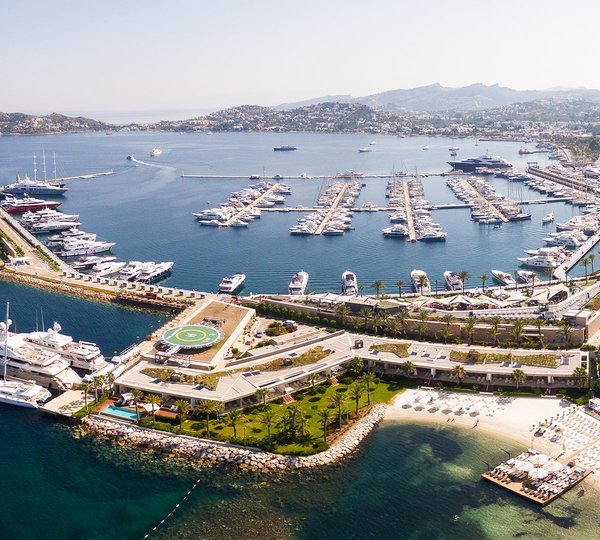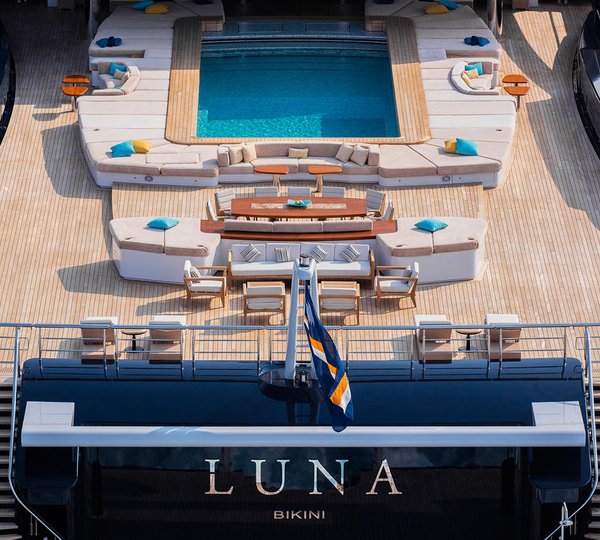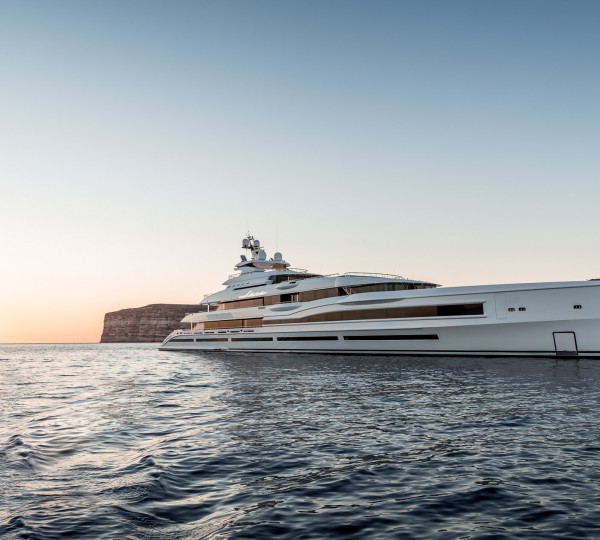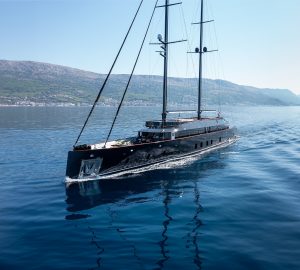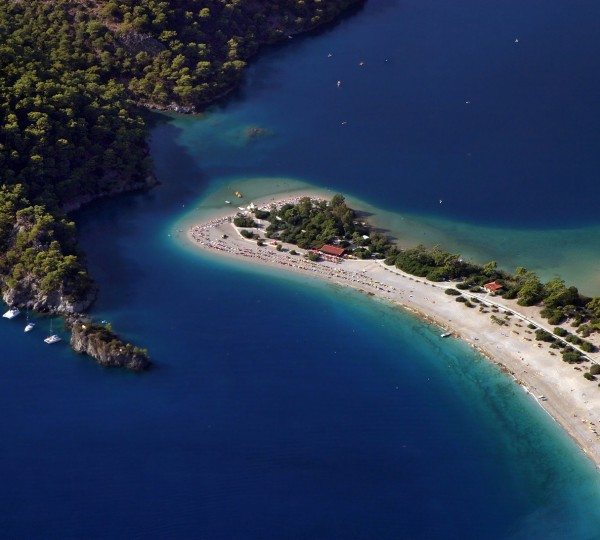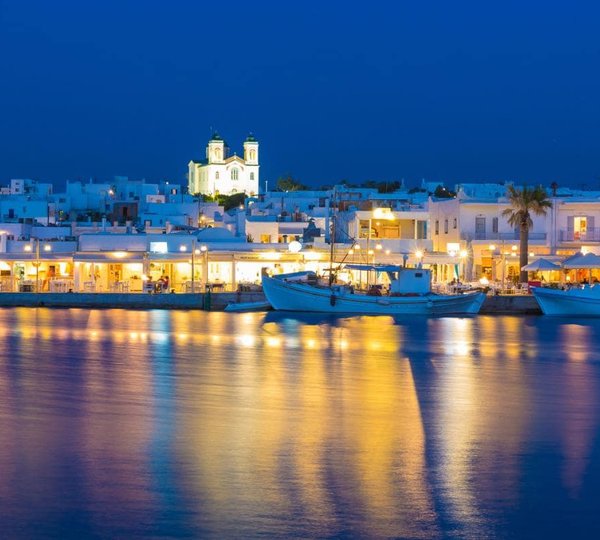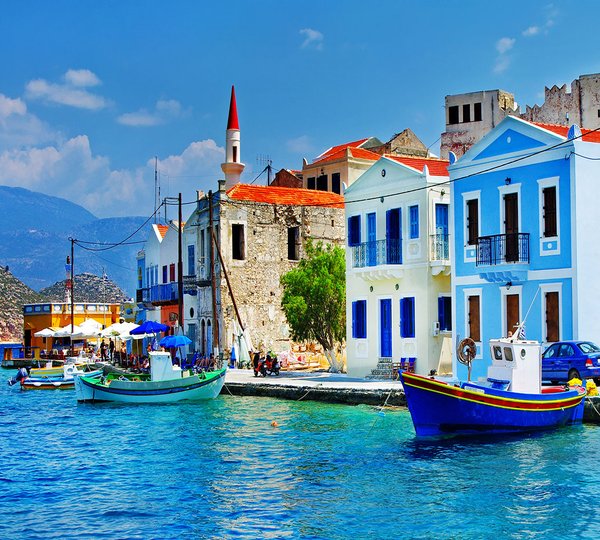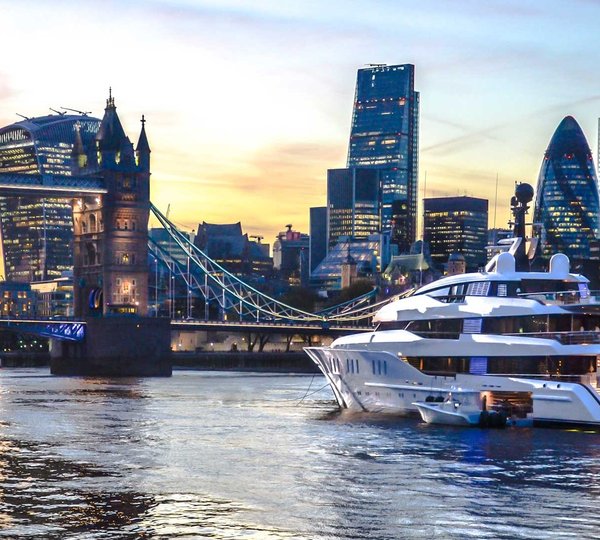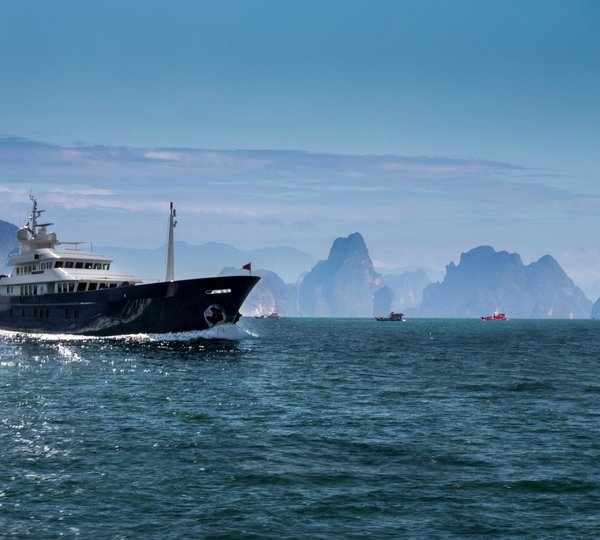A Mykonos to Bodrum Yacht Charter Itinerary has 2 Photos
Related Locations
Mykonos to Bodrum - 7 Day Yacht Charter Itinerary
Read the full Greece Charter Guide and Turkey Charter Guide.
A 7-day private yacht charter visting Mykonos, Delos, Paros, Santorini, Dodecanese and Bodrum.
Day 1:
Embark in Mykonos. One of the most cosmopolitan of all Greek islands, Mykonos has an international reputation and quite justifiably attracts a large number of tourists from all over the world, amongst them are many intellectuals and well-known artists. The high mountains encountered in most of the Cyclades islands give way to small rocky hills which combine with beautiful beaches to make up the landscape of the island. Anchor outside of Mykonos Town's "little Venice" with its row of waterfront cafes over handing the water, and have a look at the Folklore Museum and Archaeological Museum at both ends of the quay. Shop by day or take in one of Mykonos' extravagant bars for a sunset drink.
A few of Mykonos’ famous features:
Petros the Pelican - An old celebrity of the town's waterfront, "Petros" has been the official mascot of Mykonos for many years. Found after a storm in 1954 the pelican gave up its migrating to become a local resident. After more than thirty years of making the island his home, Petros eventually died. The loss of such a personality was so deeply felt by both Mykonian and tourist alike that a replacement was soon found and a tradition established. Through the care and protection of the islanders, the spirit of Petros lives on in his predecessor who continues to this day to make his home on the island's waterfront.
Windmills - One of the most recognized landmarks of Mykonos has been its windmills. Due to its geographic position, Mykonos was situated on major sea trade- route which at one time joined Venice, the gateway of Europe, to Asia. The need to refine grain and compact it for transport combined with an ample year round supply of wind made Mykonos the perfect location. Easy access to the harbor was necessary so most of the island's mills were positioned in or around the main port with the highest concentration covering the entire western portion of town. With the coming of industrialization the windmills importance began to decline as well as their numbers. Today only a fraction remains of what was once an active era in Mykonian history. Little Venice - Where the most western part of the town meets the sea is the area known as "Little Venice". Here the buildings have been constructed right on the sea's edge with their balconies overhanging the water. During the 16th and 17th century pirating was common and it is believed this area was used for the necessary quick loading and unloading of goods.
Paraportiani - One of the most famous architectural structures in Greece is the church, Paraportiani. Positioned near the main harbor entrance, this church is the central feature of the "Kastro" or castle area, the oldest section of town. It's name means inner or secondary door which it was to the Medieval stone walls which encircled the area. First begun in 1475, Paraportiani in reality is a group of five smaller churches which were constructed over a period of time and not completed until well into the 17th century. The two story structure was molded together utilizing four of it's churches to form a base for the fifth church which when placed on top formed a central domed roof.
Day 2:
Depart Mykonos bright and early and head to Delos.
This uninhabited island is one vast archaeological site and its remarkable monuments today attract throngs of visitors who come to pay homage to a place that was the cultural and religious centre of the Aegean from the 9th century BC for approximately a thousand years.
The island of Delos , isolated in the centre of the roughly circular ring of islands called the Cyclades, near Mykonos, is one of the most important mythological, historical and archaeological sites in Greece. The excavations in the island are among the most extensive in the Mediterranean; ongoing work takes place under the direction of the French School at Athens and many of the artifacts found are on display at the Archaeological Museum of Delos and the National Archaeological Museum of Athens.
Delos had a position as a holy sanctuary for a millennium before Olympian Greek mythology made it the birthplace of Apollo and Artemis. From its Sacred Harbour, the horizon shows the two conical mounds that have identified landscapes sacred to a goddess in other sites: one, retaining its pre-Greek name Mount Kynthos, is crowned with a sanctuary of Dionysus.
Investigation of ancient stone huts found on the island indicates that it has been inhabited since the 3rd millennium BC. Thucydides identifies the original inhabitants as piratical Carians who were eventually expelled by King Minos of Crete.[2] By the time of the Odyssey the island was already famous as the birthplace of the twin gods Apollo and Artemis. (Although there seems to be some confusion of Artemis' birthplace being either Delos or the island of Ortygia.) Between 900 BC and AD 100, sacred Delos was a major cult centre, where Dionysus is also in evidence as well as the Titaness Leto, mother of the above mentioned twin deities. Eventually acquiring Pan-Hellenic religious significance, Delos was initially a religious pilgrimage for the Ionians.
A number of "purifications" were executed by the city-state of Athens in an attempt to render the island fit for the proper worship of the Gods. The first took place in the 6th century BC, directed by the tyrant Pisistratus who ordered that all graves within sight of the temple be dug up and the bodies moved to another nearby island. In the 5th century, during the 6th year of the Peloponnesian war and under instruction from the Delphic Oracle, the entire island was purged of all dead bodies. It was then ordered that no one should be allowed to either die or give birth on the island due to its sacred importance and to preserve its neutrality in commerce, since no one could then claim ownership through inheritance. Immediately after this purification, the first quinquennial festival of the Delian games was celebrated there.
After the Persian wars the island became the natural meeting-ground for the Delian League, founded in 478 BC, the congresses being held in the temple (a separate quarter was reserved for foreigners and the sanctuaries of foreign deities.) The League's common treasury was kept here as well until 454 BC when n Pericles removed it to Athens. Since 1872 the École Française d'Athènes ("French School of Athens") has been excavating the island, the complex of buildings of which compares with those of Delphi and Olympia.
The island had no productive capacity for food, fiber, or timber, with such being imported. Limited water was exploited with an extensive cistern and aqueduct system, wells, and sanitary drains. Various regions operated agoras (markets). The largest slave market in the larger region was also maintained here. In 1990, UNESCO inscribed Delos on the World Heritage List, citing it as the "exceptionally extensive and rich" archaeological site which "conveys the image of a great cosmopolitan Mediterranean port.
Landmarks
• The small Sacred Lake in its circular bowl, now intentionally left dry by the island's caretakers to suppress disease
spreading bacteria, is a topographical feature that determined the placement of later features.
• The Minoan Fountain was a rectangular public well hewn in the rock, with a central column; it formalized the sacred spring in its present 6th century BC form, reconstructed in 166 BC, according to an inscription. Tightly-laid courses of masonry form the walls; water can still be reached by a flight of steps that fill one side.
• There are several market squares. The Hellenistic Agora of the Competaliasts by the Sacred Harbour retains the postholes for market awnings in its stone paving. Two powerful Italic merchant guilds dedicated statues and columns there.
• The Temple of the Delians is a classic example of the Doric order; a pen-and-wash reconstruction of the temple is illustrated at Doric order
• The Terrace of the Lions dedicated to Apollo by the people of Naxos shortly before 600 BC, had originally nine to twelve squatting, snarling marble guardian lions along the Sacred Way; one is inserted over the main gate to the Venetian Arsenal. The lions create a monumental avenue comparable to Egyptian avenues of sphinxes. (There is a Greek sphinx in the Delos Museum.) Today only seven of the original lions remain.
• The meeting hall of the Poseidoniasts of Beirut housed an association of merchant, warehousemen, ship-owners and innkeepers during the early years of Roman hegemony, late 2nd century BC. To their protective triad of Baal/Poseidon, Astarte/Aphrodite and Echmoun/Asklepios, they added Roma.
• The platform of the Stoivadeion dedicated to Dionysus bears a statue of the god of wine and the life-force. On either side of the platform, a pillar supports a colossal phallus, the symbol of Dionysus. The southern pillar, which is decorated with relief scenes from the Dionysiac circle, was erected ca. 300 BC to celebrate a winning theatrical performance. The statue of Dionysus was originally flanked by those of two actors impersonating Paposilenoi (conserved in the Archaeological Museum of Delos). The marble theatre is a rebuilding of an older one, undertaken shortly after 300 BC.
• The Doric Temple of Isis was built on a high over-looking hill at the beginning of the Roman period to venerate the familiar trinity of Isis, the Alexandrian Serapis and Anubis.
• The Temple of Hera, ca 500 BC, is a rebuilding of an earlier Heraion on the site.
• The House of Dionysus is a luxurious 2nd century private house named for the floor mosaic of Dionysus riding a panther.
• The House of the Dolphins is similarly named from its atrium mosaic, where erotes ride dolphins; its Phoenician owner commissioned a floor mosaic of Tanit in his vestibule.
• The Delos Synagogue
After lunch, continue onto Paros for the evening. Anchor in Naoussa bay at the northern end of the island. This picturesque little port is full of fishermen's houses and Athenian retreats.
Mykonos to Delos: 7NM / Approx. 1-1.5 hours Delos to Paros: 17NM to north/ Approx. 2-2.5 hours
Day 3:
Paros is paradise for good, fine-sand beaches so you may wish to enjoy them or partake in some ‘inland’ activities. Take a day trip inland to the south for the Valley of the Butterflies which pulsates with thousands of fluttering wings in summer. You can also visit the monastery of "Panagia Ekatontapiliani" which translates as the hundred gates. Out of them only 99 have been found. Try and locate the 100th!
The crew could even move the yacht around the South of Paros whilst you’re ashore so you can return for a delicious lunch onboard following by relaxation and some fun on the watertoys.
Northern Paros to Southern Paros or Antiparos: 18-20NM/ Approx. 2-2.5 hrs
Day 4:
Your crew will depart before dawn for Santorini. For the earlier risers, it would be worthwhile being on deck as you approach as the view of Santorini from the sea is the best!
Santorini sits on the ruin of an ancient drowned volcano that exploded about 1500 B.C. The view approaching the island is amazing, with sheer, striated cliffs and white cubist villages perched at the summit. On the island's western, cliff-face side, access to the top is by ancient bus, telepherique or donkey. Stop in at Franco's bar in Fira, the main town, for a drink and a gorgeous Santorini sunset overlooking a seamless custard bay where the volcano lies dormant, not dead.
Try one of the good restaurants, among them, Selene in Fira and Tomato near the airport. Inland, tour the brilliant- white Boutaris winery and visitors' center for a video show on Santorini and a guided tasting of Boutaris wines. Don't miss Santorini's superb archaeological sites, including Ancient Thira, a Doric city- fortress from the 9th century B.C. high on a southern coastal promontory, and farther south, fascinating on- going excavations at Akrotiri, which is an even earlier Minoan settlement. Walk a few meters to the far southern tip for a breathtaking black-sand moonscape beach backed by a sheer red cliff.
After dinner, settle in with a DVD or a good book as the crew cast off towards the Greek Dodecanese Islands and Turkey. This is the longest crossing on the trip and will be very much subject to weather.
Paros to Santorini: 42NM/Approx. 4 hrs Santorini to Symi: 140NM/Approx. 12-13 hours
Day 5: Symi is a quaint island in the Greek Dodecanese and it has one of the most beautiful harbors in Greece. On either side of a steep-sided fjord rise tier upon tier of houses, some white, some pastel yellow, but virtually all with neo-classical pediments - a reminder that 100 years ago this was one of Greece's most prosperous islands. The coastline of Symi alternates between steep rocks and sand and is interrupted by little coves.
Day 6:
Depart Symi and head towards Datca where you’ll clear customs into Turkey. The Datça Peninsula extends into the sea like a long, green dagger. It is connected to the mainland through the 800 m Balıkaşıran isthmus, the narrowest one in the peninsula. Without this isthmus, Datça would be an island. There are many beautiful spots to enjoy swimming and water sports.
The high-ceilinged, straight-roofed and whitewashed stone houses in the Reşadiye district suggest that a wealthy community once lived in Datça. The bay of Hisarönü on one side and Gökova on the other flanks the Datça Peninsula. The jagged shores are dotted with marvelous bays and coves. There is more to discover in the coves of the forests and mountains in the way of lovely little villages, mountains stretching over a distance of 70 km, lush vegetation and windmills
Symi to Datca: 15NM/Approx. 1.5 hrs
Day 7:
Today cruise around to enjoy one of the many picturesque anchorages in Gokova Bay as you make your way towards Bodrum. There are many beautiful islands to choose from but all offer tranquil bays and alcoves, sandy beaches and crystal clear water. It is considered the most interesting part of the coast and includes a host of wonderful sites and anchorages . Here is just a taste.
Orak Island- Famous for its rich marine life (8nm from Bodrum)
Cökertme Bay- Sheltered place for spending the night.(18nm from Bodrum)
Sedir Island ( Cleopatra Island)- Ancient Site Kedrai & Famed Cleopatra Beach is found (38nm from Bodrum)
English Harbor (32nm from Bodrum
Seven Island- Ideal stop for swimming, snorkeling and fishing. (25nm from Bodrum)
Enjoy yourselves swimming and playing on the water toys before heading into Bodrum for your last evening. Bodrum is an international Turkish city. Besides being a vacation city, it has a lot of Anatolia and Turkish history. There are many hotels, restaurants, night clubs, bars in all the surrounding bays.
A few points of interest include in Bodrum include:
Knights of Rhodes : The only underwater museum of the world stands in that castle where you can meet the powerful Queen Ada.
Bodrum Castle (Saint Petrum) : Built by the Knights of Rhodes in the 15th century and dedicated to St. Peter, the castle took 99 years to be completed. It is built on Zephyrion Island, the original site of the city of Halikarnassos. Stones and reliefs from the Mausoleum of King Mausolos were used in its construction. There are 5 towers in this castle, all of which have a name: French, English, Italian, German and Snake tower. The castle covers approximately 30,000 sq. meters.
The Underwater Archeological Museum of Bodrum : It is one of the most important and biggest museums of its kind in the world. The relics recovered from excavations which started in the 1960's are on display in this museum located in the Bodrum Castle. The Eastern Mediterranean amphora collection as well as findings resulting from research on sunken ships in the immediate vicinity is on display. The remains of the oldest known sunken ship in the world are also here and well-worth seeing.
Mausoleum Open Air Museum : It gets its name from the fact that the tomb of Mausolos, the King of Caria, is located here. His wife and sister had the most famous architects of the day design the structure. It was almost completely destroyed in the Great Anatolian earthquake. There is a small museum here at the site of this tomb which was one of the seven wonders of the ancient world. The word "maussolleion" is taken from King Mausolos' name. Many of the stones of this Mausoleum were used in the construction of Bodrum Castle. The beautiful reliefs on the grave, however, were taken to the British Museum during the excavations in the 19th century.
Datca to Bodrum: 50NM/Approx. 4-5 hours (which can be broken up with a lunchtime anchorage)
Quick Enquiry
Charter Yacht Disclaimer
This document is not contractual. The yacht charters and their particulars displayed in the results above are displayed in good faith and whilst believed to be correct are not guaranteed. CharterWorld Limited does not warrant or assume any legal liability or responsibility for the accuracy, completeness, or usefulness of any information and/or images displayed. All information is subject to change without notice and is without warrantee. A professional CharterWorld yacht charter consultant will discuss each charter during your charter selection process. Starting prices are shown in a range of currencies for a one-week charter, unless otherwise marked. Exact pricing and other details will be confirmed on the particular charter contract. Just follow the "reserve this yacht charter" link for your chosen yacht charter or contact us and someone from the CharterWorld team will be in touch shortly.

